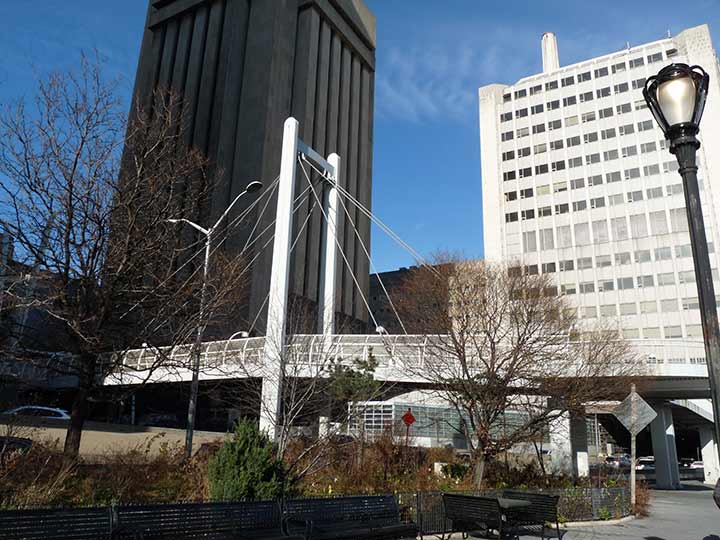
ROCKEFELLER University’s pedestrian cable-stayed bridge, designed by Weidlinger Associates, connects the university’s south campus and residence halls, spanning busy East 63rd Street, which here is an on and off ramp for the Franklin D. Roosevelt Drive. The bridge is 120 feet in length and 8 feet wide. The 80-foot high V-shaped tower balances the weight of the deck along with the support cables. The steel bridge was completed in 2000 at a cost of $1.9 million.
The FDR Drive is also spanned by a small pedestrian suspension bridge that likely is of the same vintage as the cable-stayed bridge — the two bridges are of the same materials and resemble the other. Both of these small pedestrian bridges are, of course, dwarfed by the Bridge With Three Names — the Queensboro/59th Street/Ed Koch Bridge, completed in 1909. As Steve Anderson reports in nycroads, the bridge was originally going to be called the Blackwell’s Island Bridge.
The Rockefeller University was founded in 1901 by John D. Rockefeller Sr. as The Rockefeller Institute for Medical Research. The first institution in the United States devoted solely to using biomedical research to understand the underlying causes of disease, Rockefeller is today one of the foremost biomedical research centers in the world, and its scientists have made numerous seminal contributions to biology and medicine. Over the years, 24 scientists associated with the university have received Nobel Prizes and 21 have earned the Albert Lasker Medical Research Award. Fourteen Rockefeller scientists have received the Gairdner Foundation International Award and 14 have been given the National Medal of Science, the nation’s highest scientific honor. In addition to a century of prize-winning breakthroughs, Rockefeller has devoted over half a century to training the next generation of innovative, pathbreaking scientists. Rockefeller University
This info is culled from a walk I did in 2012, in which I sought out Manhattan’s three small cable-stayed bridges, at the time the only two such located in New York City. Since then, two massive cable-stayed spans have appeared, the New Kosciuszko Bridge and the New Goethals (which I have yet to travel on).
As always, “comment…as you see fit.” I earn a small payment when you click on any ad on the site. Take a look at the new JOBS link in the red toolbar at the top of the page on the desktop version, as I also get a small payment when you view a job via that link.
11/29/24


3 comments
Don’t look like no V-shaped tower to me!
I think that’s the bridge that goes over the FDR…the V-shaped one crosses over 63rd St. (and the other bridge) to connect two Rockefeller Univ. buildings.
The Brooklyn Bridge is cable-stayed as well as suspension, the Roeblings going full-belt-and-suspenders, so to speak…